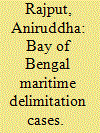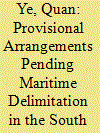|
|
|
Sort Order |
|
|
|
Items / Page
|
|
|
|
|
|
|
| Srl | Item |
| 1 |
ID:
145655


|
|
|
|
|
| Summary/Abstract |
The judgments in maritime delimitation cases involving Bangladesh and Myanmar (2012) and between Bangladesh and India (2014) have resulted in a “Grey Area” in the northern Bay of Bengal involving intersecting and overlapping rights and responsibilities in terms of the exclusive economic zone (EEZ) and continental shelf regimes. This article seeks to identify a functional solution for this Grey Area.
|
|
|
|
|
|
|
|
|
|
|
|
|
|
|
|
| 2 |
ID:
162735


|
|
|
|
|
| Summary/Abstract |
At a time when there are instances of lack of participation in binding dispute resolution mechanisms under the UNCLOS, the Bay of Bengal Arbitrations provide a ray of hope and adherence to the rule of law. The three Bay of Bengal States: Bangladesh, India and Myanmar settled their long standing disputed claims over the maritime zones in the Bay of Bengal in a peaceful manner. These cases represent that States relatively stronger on the political level as compared to others are willing to compromise their positions and adhere to the outcome of dispute resolution proceedings under the UNCLOS. These cases involved sensitive issues such as the determination of the land boundary terminus, based upon the reports and other proceedings relating to the partition of India. There were other controversial claims over certain islands, which too were presented for adjudication and the decision was thereafter complied with all the parties to the dispute. These cases thus constitute a prime example of the importance of adherence to a rule based system for maritime claims.
|
|
|
|
|
|
|
|
|
|
|
|
|
|
|
|
| 3 |
ID:
172432


|
|
|
|
|
| Summary/Abstract |
This article examines the practice of the international judicial and arbitral tribunals thus far in delimiting the continental shelf beyond 200 nm, and indicates the trend reflected in the decisions. However, the article disagrees with the critical observation of the tribunals that the delimitation method for the continental shelf beyond 200 nm should follow that within 200 nm. The delimitation of the continental shelf beyond 200 nm is essentially different from the single maritime delimitation within 200 nm, and various methods may be employed in order to achieve an equitable result in a particular case.
|
|
|
|
|
|
|
|
|
|
|
|
|
|
|
|
| 4 |
ID:
131368


|
|
|
|
|
| Publication |
2014.
|
| Summary/Abstract |
This article considers the law of maritime delimitation as applied by the International Tribunal for the Law of the Sea in the 2012 Bangladesh v. Myanmar case. The dispute concerned the delimitation of the maritime boundary between the two states in the northern part of the Bay of Bengal. The decision demands a particular examination since it was the first delimitation dispute decided by the Tribunal. The article traces how the ITLOS applied and developed the methodology of maritime delimitation. It also analyzes the ascertainment of a true nature of international instruments as well as unilateral acts of states before international courts and tribunals.
|
|
|
|
|
|
|
|
|
|
|
|
|
|
|
|
| 5 |
ID:
175494


|
|
|
|
|
| Summary/Abstract |
China and North Korea have delimited the boundary of their territorial seas by signing a 1962 Border Treaty and a 1964 Border Protocol, but the two states still need to delimit the boundary of their exclusive economic zones (EEZs) and continental shelves (CSs) in the North Yellow Sea (NYS). Considering the geographical characteristics of the two states’ coasts in the NYS, this article proposes that China and North Korea can delimit a single maritime boundary for the EEZ and the CS by applying the equidistance/relevant circumstances method, and then following a “three-stage approach.” The first stage is to construct a provisional equidistance line in the NYS; the second stage is to adjust the provisional equidistance line in light of relevant circumstances, such as the partial effect of Nan Tuozi in light of its distance from the coast of the continent; and the third stage is to apply the disproportionality test to the maritime area allocated to the two states in the NYS. After applying the “three-stage approach” to this case, the author concludes that the potential delimitation line of EEZ/CS between the two states extends generally south-southwest through seven segments for a distance of about 196 km (106 nm). Since 2018, tensions appear to have declined on the Korean Peninsula, and this may provide an opportunity for China and North Korea to start their maritime boundary delimitation negotiation in the near future.
|
|
|
|
|
|
|
|
|
|
|
|
|
|
|
|
| 6 |
ID:
191901


|
|
|
|
|
| Summary/Abstract |
China and South Korea resumed negotiations on delimiting their maritime boundary in 2015. The overlapping maritime area of China and South Korea requiring delimitation lie mainly in the South Yellow Sea (SYS). This article proceeds on the basis that the two states probably reached a preliminary agreement on the limits of the first-stage maritime delimitation area, in which there are no third-party interests involved. This article selects 37°N and 32°N as the northern and southern limits of the first-stage maritime delimitation area on the basis of public information available. This article proposes that China and South Korea can delimit a single maritime boundary for their exclusive economic zones (EEZs) and continental shelves by applying the equidistance/relevant circumstances method, and then following the three-stage approach. After applying the three-stage approach to this case, this author concludes that the adjusted equidistance line/potential delimitation line will probably move toward South Korea, departing from the provisional equidistance line. The potential delimitation line of EEZ/continental shelf between the two states probably extends generally south-southwest-southeast. This author calculates that the coastal length ratio between the two states is approximately 1:2.14 in favor of China and the ratio of the relevant baselines length is approximately 1:1.47 in favor of China. This author deduces that the ratio of the allocated relevant areas is approximately 1:1.17 in favor of China and the ratio of the allocated provisional measure zone (PMZ) of the 2000 China–ROK Fishery Agreement is approximately 1:1.44 in favor of China, both under the adjusted equidistance line scenario, measured by the WGS 1984 Web Mercator.
|
|
|
|
|
|
|
|
|
|
|
|
|
|
|
|
| 7 |
ID:
173425


|
|
|
|
|
| Summary/Abstract |
State practice reveals that the main reason states conclude maritime delimitation agreements is their desire to reap the benefits accruing from offshore natural resources, especially hydrocarbons. However, international jurisprudence has not expressly taken nongeographical factors into consideration in delimitation cases, even though it has also not totally disregarded them. Since such factors individually have been in the judges’ minds, it is suggested that if a state is capable of proving that these factors indicate the existence of fundamental interests in an undelimited area, all of those should be contemplated in accumulation and form a distinct concept, namely, the “predominant interest.” In a nutshell, the concept analyzed in this article refers to the aggregation of a gamut of nongeographical factors that, although they have not been taken into consideration separately in delimitation cases, tend to evince the existence of fundamental interests, which form a broader one, namely, the “predominant interest.” This article proposes that the “predominant interest” concept could be utilized by international courts and tribunals in order to check the equitableness of a maritime boundary at the second stage of the delimitation process concerning the continental shelf/exclusive economic zone (EEZ), after relevant circumstances predicated on geographical factors have been examined. In any case, though, it is asserted that this concept should not be invoked so as to justify excessive claims. To the contrary, it should be applied in support of contentions made in good faith with a view to safeguarding the essential interests of a state.
|
|
|
|
|
|
|
|
|
|
|
|
|
|
|
|
| 8 |
ID:
163788


|
|
|
|
|
| Summary/Abstract |
As an extremely delicate and sensitive matter, it is unrealistic to expect the eventual
resolution of maritime delimitation disputes in the South China Sea (SCS) in the
immediate future. To manage the disputes and utilize the disputed maritime area,
the claimants in this region have made continued efforts to conclude provisional
arrangements. Due to the lack of consensus on the precise disputed zones and the
low political will to make concessions, the existing arrangements have several
drawbacks. To break the stalemate, a set of approaches are indispensable. A
reasonable first step might be to develop provisional arrangements in less disputed
maritime areas, especially those areas involving only two states. For areas with
multiple claims or where the claimants have low political will to cooperate, it is
advisable to start with developing arrangements on issues with common interests
and easy to implement. For higher sensitive issues, track two connections might be
employed at first, so as to pave the way for future official cooperation.
|
|
|
|
|
|
|
|
|
|
|
|
|
|
|
|
| 9 |
ID:
142288


|
|
|
|
|
| Summary/Abstract |
Unilateral exploration and exploitation of natural resources in disputed marine areas create a sensitive issue in the context of maritime delimitations. In the Ghana/Côte d'Ivoire dispute concerning maritime delimitation, Côte d'Ivoire requested that the Special Chamber of International Tribunal for the Law of the Sea (ITLOS) prescribe provisional measures to suspend all ongoing oil exploration and exploitation operations conducted by Ghana in the disputed area and to refrain from granting any new permit for oil exploration and exploitation there. In the Order of 2 April 2015, the Special Chamber declined the Côte d'Ivoire's request to prescribe the suspension of operations but did order that Ghana ensure that no new drilling either by Ghana or under its control take place in the disputed area. The Ghana/Côte d'Ivoire Order sheds light on the legal consequence of unilateral exploration and exploitation of natural resources in disputed marine areas.
|
|
|
|
|
|
|
|
|
|
|
|
|
|
|
|
|
|
|
|
|